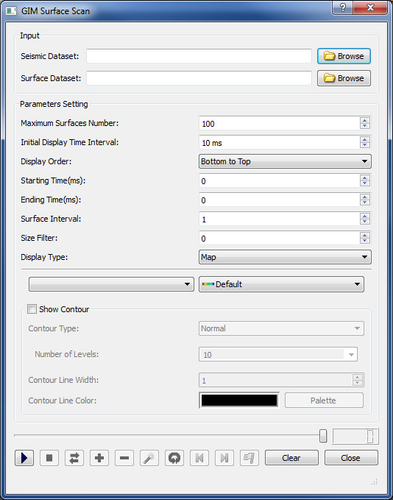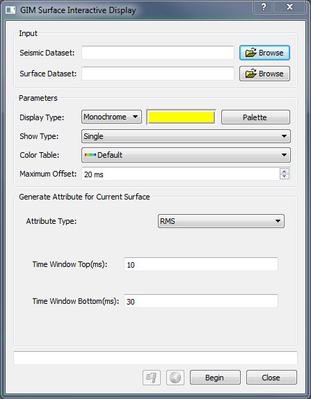Introduction
GIM offers several ways to visualize trackings and surfaces depending on what you are looking for and want to achieve.
On this page:
Tracking scan
The tracking scan is an excellent tool for evaluating the tracking dataset and see how the stratigraphy in the cube is represented by the tracking. The tracking scan displays a set of inline or crossline trackings with a short time interval, and then displays the next set, making it look like a movie is played through the tracked cube.
Open the tracking scan from GIM > GIM Data Visualization > Surface Interactive. Select Seismic Dataset and Surface Dataset.
Tracking scan menu
Select the seismic dataset, inline tracking or crossline tracking and select the tracking dataset. Adjust the parameter settings to your need:
- Maxium trackings number
- Initial display time interval
- Display order
- Start tracking slice/End tracking slice
- Tracking interval
- Display type
Start the scan by clicking the play button. You can pause or stop the scan anytime. Use the plus and minus buttons to increase and decrease the speed. You can also set the scan to loop, which makes it start over again when it has reached the end. To manually scan through the trackings click the pause button and use the arrows to go back and forth.
Surface scan
Scanning through a GIM surface database is an effective way to familiarize oneself with the 3D stratigraphy. It is also a very effective way to looking through the entire cube evaluating the surfaces based on relief, attribute and shape. The surface scan is most often used to display all surfaces or a set of surfaces in a series, or by displaying surfaces one-by-one.
Open the surface scan from Tools -> GIM Data Visualization -> Surface Scan. Select Seismic Dataset and Surface Dataset.
Surface scan menu
Parameter settings
- Maximum surfaces number
- Initial display time interval
- Display order
- Starting time
- Ending time
- Surface interval
- Size filter
- Display type
Enable contours by checking the Show contour box and adjusting the appropriate parameters.
Scan one-by-one
The best way to scan through the surfaces one-by-one is to look at them from above in 2D mode. Display the outline of the cube and set the graphics window in 2D. In order to scan through the surfaces set the Maximum surfaces number to 1 and the size filter to 1000. Set the display type to map surfaces with time.
Start the scan by clicking the play button, and Geocap will display the first surface. If you have generated amplitudes for the surfaces you can switch between displaying time and amplitude by pressing N on the keyboard. Go to the next surface by clicking the button or the right arrow on the keyboard. Go back with the button or the left key on the keyboard.
Tag interesting surfaces by pressing T on the keyboard or the button in the surface scan menu.
Display multiple surfaces
It can often be valuable to display several or all of the surfaces to get familiarized with the 3D surface database. A good way to do this is to display the 500-1000 biggest surfaces. The appropriate settings required to achieve this will of course vary from cube to cube, but a good starting point would be to set the size filter to 2000 and the maximum surface number to 1000. Click the play button and wait for the surfaces to start loading. This can take some time depending on the speed of your computer.
When the surfaces have been loaded Geocap will start displaying them. You can see the amount of surfaces loaded at the bottom of the GIM surface scan menu.
If the number of loaded surfaces is:
- Less than 500
- 1000
Surface interactive
Surface interactive lets you display surfaces by clicking on seismic reflectors in the graphical window. Go to Tools > GIM Data Visualization > Surface Interactive. Select Seismic Dataset and Surface Dataset.
Surface interactive menu
Adjust the following parameters to your need:
- Display Type
- Show Type
- Color Table
- Maximum Offset
To start displaying surfaces interactively click Begin and go to the graphics winodow. Display a surface by positioning the cursor on a reflector and clicking Y on the keyboard.
It is possible to create attributes, such as amplitude, RMS and facies on picked surfaces. Select attribute type and parameters and click the button.
It is also possible to tag surfaces for export to disk, project etc. Click the button to tag a surface.
From list
Display from list is great to use when you want to display the tracking for a specific inline or crossline, or display a specific surface which you know the number of.
Select a Seismic dataset and then Inline tracking, Crossline tracking or Surfaces as type, and select the dataset. Select one entry (tracking slice or a surface) to display and click Display. For tracking data you can display Horizon, Positive through or Negative peak. Select the color by using the Palette. For surfaces you can Map by time or attribute, or display in a single color by using Monochrome.
You can send one or several datasets from the list to the Geocap project by right-clicking them and select Send to project.





